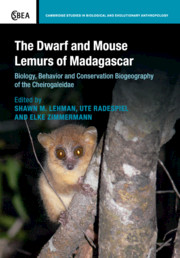 The Dwarf and Mouse Lemurs of Madagascar
The Dwarf and Mouse Lemurs of Madagascar Book contents
- Frontmatter
- Contents
- List of contributors
- Foreword
- Part I Cheirogaleidae: evolution, taxonomy, and genetics
- Part II Methods for studying captive and wild cheirogaleids
- 6 How to anesthetize mouse lemurs
- 7 Microcebus murinus – a unique primate for modeling human brain disorders, including Alzheimer's disease and bovine spongiform encephalopathy
- 8 Life history variation in mouse lemurs (Microcebus murinus, M. lehilahytsara): the effect of environmental and phylogenetic determinants
- 9 The effects of the lunar cycle, temperature, and rainfall on the trapping success of wild brown mouse lemurs (Microcebus rufus) in Ranomafana National Park, southeastern Madagascar
- 10 Tiny samples from tiny lemurs: methodological considerations for endoparasite analyses in mouse lemurs
- 11 A review of ectoparasites in the Cheirogaleidae
- Part III Cheirogaleidae: behavior and ecology
- Part IV Cheirogaleidae: sensory ecology, communication, and cognition
- Part V Cheirogaleidae: conservation biogeography
- Index
- Plate section
- References
6 - How to anesthetize mouse lemurs
from Part II - Methods for studying captive and wild cheirogaleids
Published online by Cambridge University Press: 05 March 2016
- Frontmatter
- Contents
- List of contributors
- Foreword
- Part I Cheirogaleidae: evolution, taxonomy, and genetics
- Part II Methods for studying captive and wild cheirogaleids
- 6 How to anesthetize mouse lemurs
- 7 Microcebus murinus – a unique primate for modeling human brain disorders, including Alzheimer's disease and bovine spongiform encephalopathy
- 8 Life history variation in mouse lemurs (Microcebus murinus, M. lehilahytsara): the effect of environmental and phylogenetic determinants
- 9 The effects of the lunar cycle, temperature, and rainfall on the trapping success of wild brown mouse lemurs (Microcebus rufus) in Ranomafana National Park, southeastern Madagascar
- 10 Tiny samples from tiny lemurs: methodological considerations for endoparasite analyses in mouse lemurs
- 11 A review of ectoparasites in the Cheirogaleidae
- Part III Cheirogaleidae: behavior and ecology
- Part IV Cheirogaleidae: sensory ecology, communication, and cognition
- Part V Cheirogaleidae: conservation biogeography
- Index
- Plate section
- References
Summary
Introduction
Mouse and dwarf lemurs are the smallest primate species. They may be used in a variety of scientific projects under field or laboratory conditions. Despite trap capture and the small size of mouse and dwarf lemurs, for successful performance of some procedures animals need to be anesthetized (Glander, 2013). In particular, the very small size of mouse lemurs with a body mass of 20–100 g and a body length of 5–13 cm (Louis et al., 2008) requires special considerations for anesthesia and might limit the use of standard veterinary anesthesia equipment and techniques in the field.
To choose the best anesthetic method for a project, different factors such as drugs and available equipment, type, invasiveness and duration of procedure, possible interaction of drugs with measured parameters, and the experience of the scientist should be considered. In the face of modern imaging methods and the use of mouse lemurs as a research model of human disease, more prolonged anesthetics and sensitive monitoring of vital parameters, ventilation, and oxygenation becomes necessary to maintain physiological conditions.
Therefore, the purpose of the current article was to discuss general considerations for anesthesia in an animal of the size of mouse lemurs relating to equipment, and the properties and effects of anesthetic drugs. In addition, a review of published drug doses and drug combinations used for various procedures in mouse lemurs is included.
Material and methods
Publications concerning anesthesia techniques in mouse and dwarf lemurs were found by searching “Pubmed” of the United States National Library of Medicine, “Veterinary Science” of CAB International and Web of Science. These databases were searched for the following words or terms: “mouse lemur,” “dwarf lemur,” “Microcebus,” “Cheirogaleus”, alone or in combination with the word “an*esthesia.”
The search covered the period from 1959 to January 2014. Articles were scrutinized for description of immobilization or anesthesia techniques. Relevant articles were selected manually. Abstracts of conference proceedings were included only when material and methods and results were clearly stated.
Results
Vital parameters
Regardless of which anesthetic technique is used, knowledge of basic physiological variables of the species of interest, such as heart rate, respiratory rate, and body temperature, is useful to successfully monitor the animals' response (respiratory and cardiovascular depression) to anesthesia. Based on the influence of drugs, handling or capture stress and activity state, these values can vary considerably.
- Type
- Chapter
- Information
- The Dwarf and Mouse Lemurs of MadagascarBiology, Behavior and Conservation Biogeography of the Cheirogaleidae, pp. 135 - 160Publisher: Cambridge University PressPrint publication year: 2016
References
- 2
- Cited by
